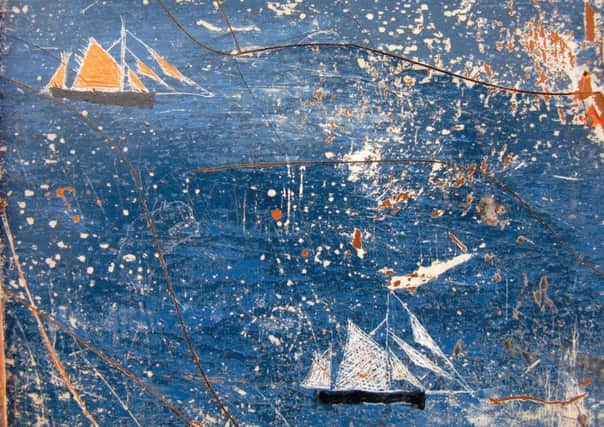Art review: Graham Rich, Paul Furneaux and Anna S King, Pittenweem Arts Festival


Graham Rich Old Town Hall, Pittenweem *****
Paul Furneaux Lesser Church Hall, Pittenweem *****
Anna S King Old Men’s Club, Pittenweem ****
Pittenweem is a postcard-perfect little town, but it is also a working harbour with serious-looking boats and a smell of fish. What better artist to choose to invite to the annual arts festival, then, than Graham Rich, artist-poet of the sea? Rich’s methods seem simple, but the best poetry often does seem simple, however sophisticated it may be in fact. He finds pieces of driftwood or other weathered material and turns them into seascapes simply by adding singly or in groups his signature motif, a two-masted, lug-sailed ketch with its sails set. These found canvases may be on their own, or one of several scattered across a surface, but they always read as the sea, no matter whether they are the whole side of a speedboat or the inside of a rusty sardine tin. Sometimes the sea is stormy. Sometimes it is calm enough for the little ship’s reflection to be visible. Often the found object is eloquent enough by itself. In North Wall, for instance, the support is a sheet of plywood with traces of flaky grey paint. A tiny ship painted in the middle turns this into a wide seascape with stormy weather approaching and so invokes the loneliness of the wide ocean. In two small works, Red Window St Ives and Fragile Sea, Blagdon Boatyard, flaking red, blue or orange paint and weathered wood are enough to suggest a little ship sailing through a brilliant sunset.
While traces of the original paint and other marks on the material are always part of the image, the artist also occasionally enhances the effect, scumbling white paint over the surface, for instance, to suggest light. Occasionally too there are touches of drawing. A pier may be indicated as it is in Approaching the Pier Head, Turf Lock, for instance. In Sailing on Lochan Eck a few swans have joined the little ship. Lochan Eck is at Little Sparta and another tiny drawn detail suggests the thatched Goose Hut that Ian Hamilton Finlay built on its bank. Finlay was a great admirer of Rich’s work and this relationship points to the poetic dimension in it. Even though he rarely uses words directly, Rich creates a poetic language of the sea. He also makes that poetic link directly in a boat he has reconstructed out of scraps of driftwood, a ghost, or perhaps a resurrection. Among a miscellany of scraps pinned to it is a piece of paper, brown from exposure, with part of “The Dry Salvages”, the third poem in TS Eliot’s Four Quartets, printed on it. This is very much a poem of the sea: “The sea has many voices,/Many gods and many voices,” Eliot writes. The sea’s many voices are Rich’s subject too and Thinking of Bas Jan Adler, the largest and most impressive work here, illustrates that very well. The support is the whole side of a speedboat, the lines of its ribs clearly visible on the weathered grey paint. Here Rich has not only painted his little ships. He has also scratched in buoys and sea marks and collaged on small photos of ships and the sea. Some are clear, others have been worked on so that the original image is shrouded in mist. Bas Jan Adler was a Dutch performance artist who disappeared at sea and so this work becomes a memorial, a poetic reflection on his final voyage and the mystery of his disappearance. Here, too, Rich is with Eliot: “There is no end of it... / To the drift of the sea and the drifting wreckage.”
Advertisement
Hide AdAdvertisement
Hide AdThere is a nice match between Rich’s work with its subtle surfaces and use of wood and the work of Paul Furneaux who is also an invited artist. After studying in Japan, Furneaux became a master of the Japanese technique of printing with multiple coloured woodblocks. Unlike the more familiar printmaking techniques, it needs no massive presses, or other heavy equipment, just wood, paper and watercolour applied with no more than the hand’s pressure. On duty in his exhibition, he cheerfully demonstrates the simplicity of the technique to visitors. Like Rich’s work, however, though it seems simple, the poetic subtlety of the result is a measure of the great skill with which such simple means are deployed. Furneaux’s most usual images reflect the technique directly as he composes with blocks of colour which are the shapes of the blocks themselves. Into that apparently straightforward matrix, however, he works endless delicate variations of texture and transparency by varying the density of the watercolour which is naturally transparent, or by laying one colour over another. He creates textures in his blocks, but also often allows the woodgrain to show through to great effect. Even using the same set of blocks, the result is that no two prints are the same. At times too he also moves away from his favoured grid composition to images that are more loosely composed, or even, in a homage to his inspiration in the work of the great Japanese master Hokusai, to produce a print of Mount Fuji itself.
The third invited artist is Anna S King whose work is also exquisite. She too works with paper and her artist’s books are familiar, but in much of what is on show she uses paper almost as a sculptural medium, cutting and joining it to make fascinating three dimensional objects, their textures as delicate as bird’s feathers.
The Pittenweem Arts Festival runs until 13 August